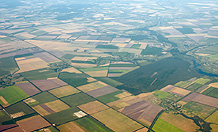
The research findings have prompted an urgent call for landowners and policy makers to reduce greenhouse emissions. Image courtesy of Shutterstock
Global farming practices must change, say climate change researchers
Human activities such as farming have caused the world’s plants, animals and microbes to contribute to global warming, a major international study co-authored by a University of Exeter professor has found.
The research findings have prompted an urgent call for landowners and policy makers to reduce greenhouse emissions from livestock and arable agriculture, which have transformed the earth’s land biosphere and its ability to mitigate climate change.
Professor Pierre Friedlingstein of the College of Engineering, Mathematics and Physical Sciences, was one of a team of 23 scientists from 16 institutions in four countries, which found that human activities have produced damaging levels of methane and nitrous oxide gases and damaged the biosphere’s capacity act as a carbon sink and mop up CO2 emissions.
Scientists have previously largely focused on the impact of carbon dioxide (CO2) when considering the impact of greenhouse gases. This study, published in the leading scientific journal Nature, is the first to examine the net balance of the three major greenhouse gases - carbon dioxide, methane and nitrous oxide - in the land biosphere. It examined the impact of human activities worldwide over the past three decades.
“From both science and climate policy perspectives it is of critical importance to look at the overall balance of the three major greenhouse gases in the land biosphere. We found that the cumulative warming capacity of methane and nitrous oxide emissions by far exceeds the cooling effect of global land carbon dioxide uptake, based on the global warming potential over the next 100 years,” said Professor Friedlingstein.
“The world’s forests and grasslands are still acting as carbon sinks, helping to mitigate CO2 emissions. However, human activities such as agriculture and waste management also induce CH4 and N2O emissions. We always assumed that these were small players relative to the large carbon sinks. This study demonstrates that this is not the case anymore. It is crucially important that these findings are taken into account by scientists, campaigners and policy makers if we are to reduce the damage caused by these gases and work towards the mitigation of climate change,” he added.
Hanqin Tian, director of the International Center for Climate and Global Change Research at Auburn University in Alabama, and lead author of the study said: “The global warming potential of methane and nitrous oxide are 28 and 265 times larger than that of carbon dioxide, respectively.
“This finding reveals for the first time that human activities have transformed the land biosphere to act as a contributor to climate change. We suggest that adoption of best practices by policymakers and landowners to reduce greenhouse emissions from human-impacted land ecosystems could reverse the biosphere’s current warming role.”
The study also found that human-caused biogenic fluxes of these gases in Southern Asia, a region including China and India, led to a larger net climate warming effect, compared to other regions. A major source of human-caused methane emission comes from rice cultivation and livestock, while a major source of nitrous oxide is from the use of manmade fertilizers.
Co-author Anna Michalak of Carnegie Institution for Science in Stanford, California, said: "Here we bring together information from dozens of sources to show that human actions, on a global scale, have caused the world's plants, animals and microbes to contribute to global warming."
Josep Canadell, executive director of the Global Carbon Project in Australia, added: “The results are a big wake-up call for the global climate community that show the way we are managing our lands is not sustainable and not consistent with stabilizing the climate at low temperature scenarios. How we manage the global lands needs to become a central part in our strategy to mitigate global warming.”
The terrestrial biosphere as a net source of greenhouse gases to the atmosphere by Hanqin Tian, Chaoqun Lu, Philippe Ciais, Anna M. Michalak, Josep G. Canadell, Eri Saikawa, Deborah N. Huntzinger, Kevin Gurney, Stephen Sitch, Bowen Zhang, Jia Yang,Philippe Bousquet, Lori Bruhwiler, Guangsheng Chen, Edward Dlugokencky, Pierre Friedlingstein, Jerry Melillo, Shufen Pan, Benjamin Poulter, Ronald Prinn, Marielle Saunois, Christopher R. Schwalm, Steven C. Wofsy is published in Nature.
Date: 10 March 2016
